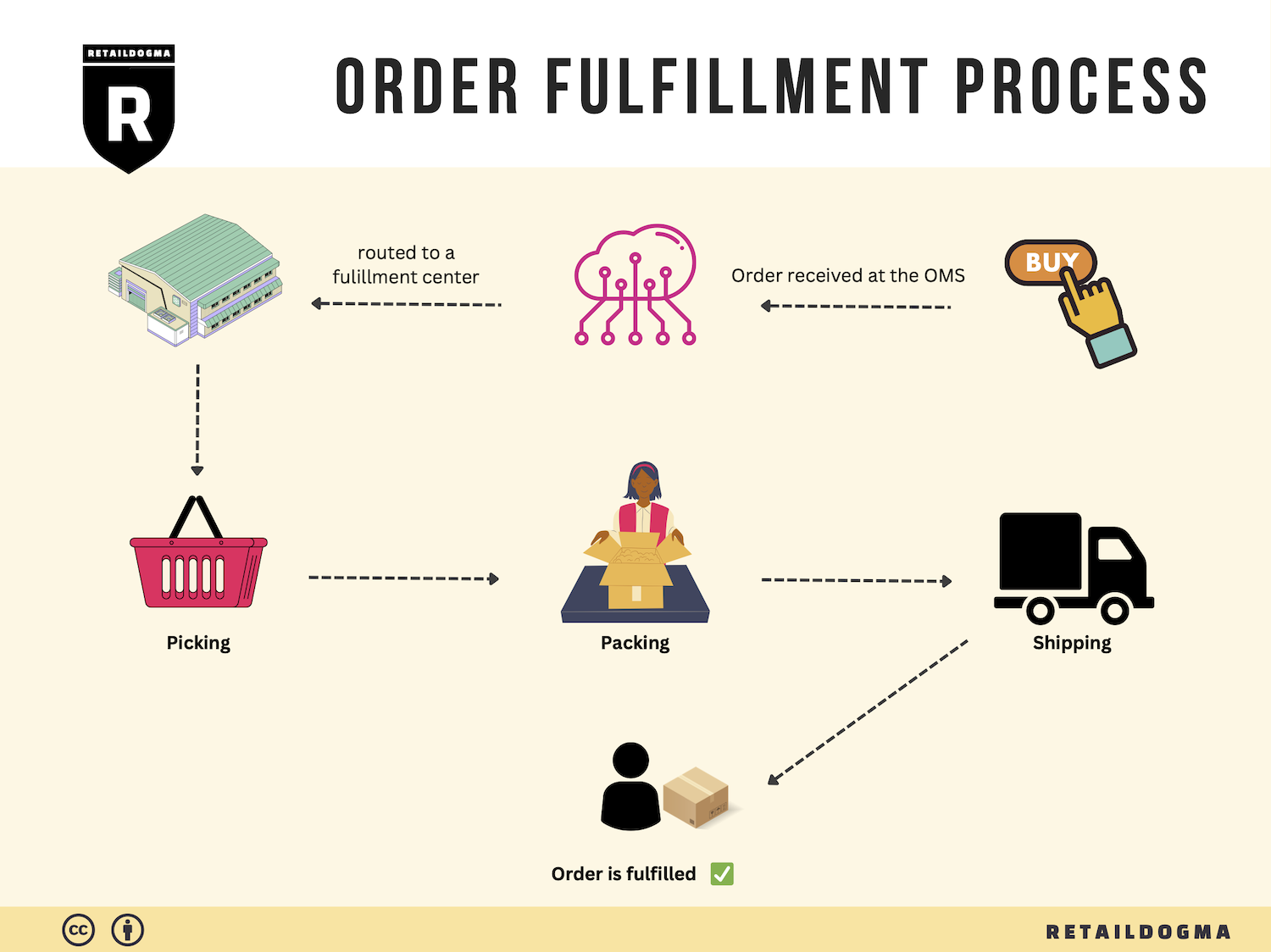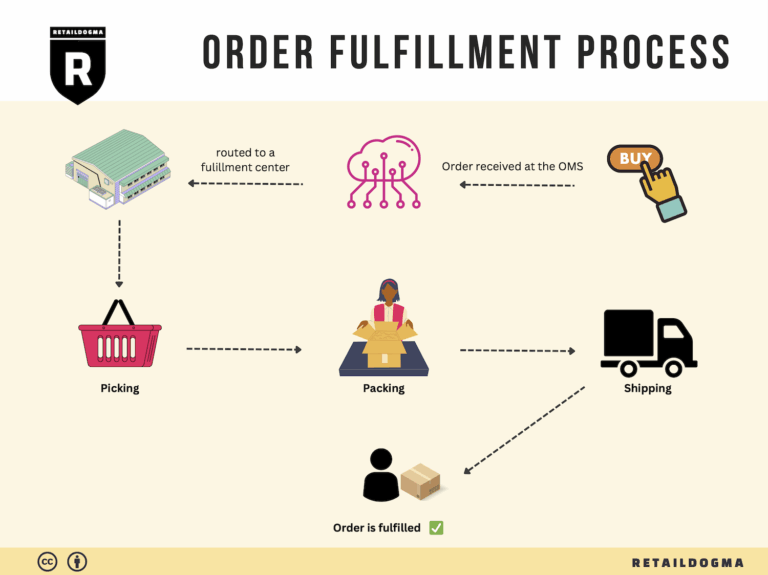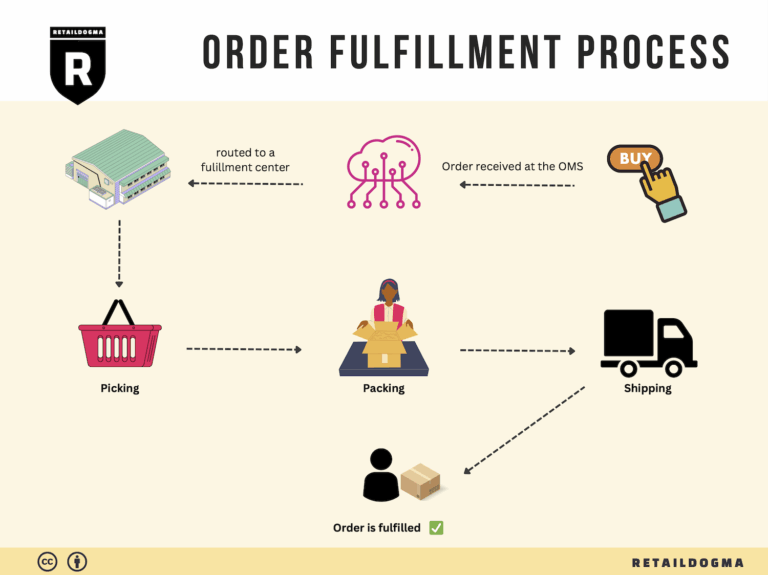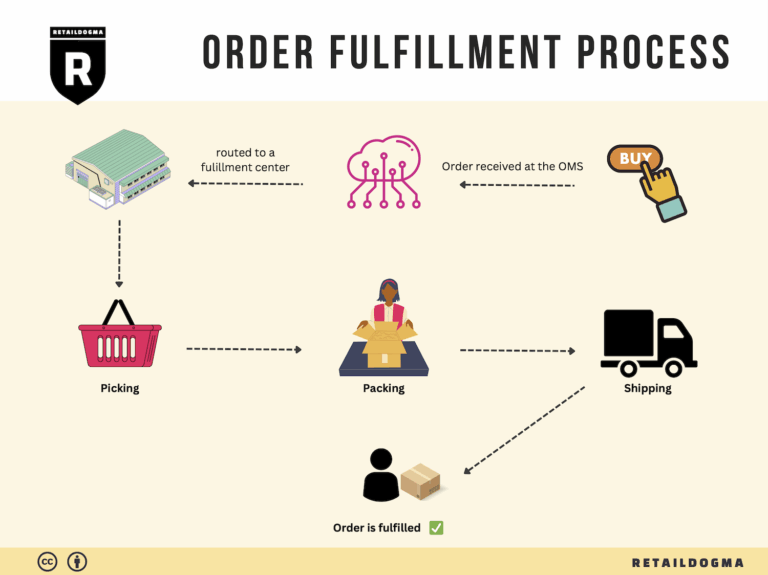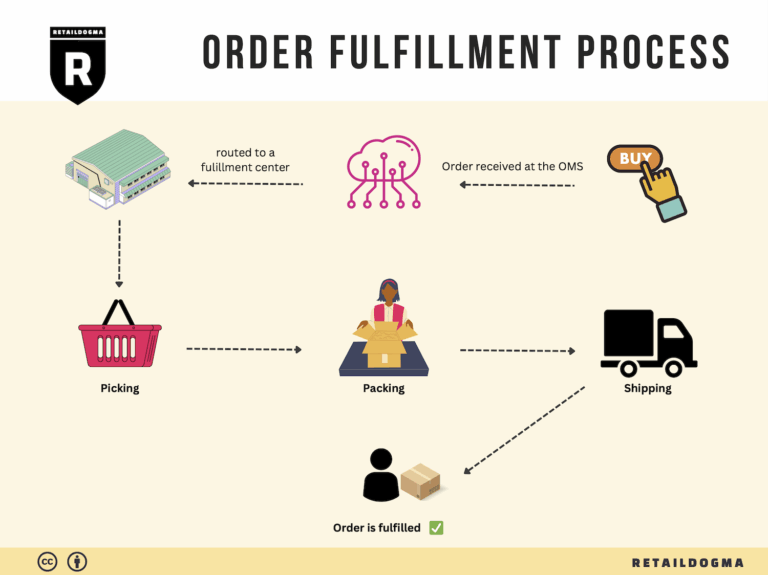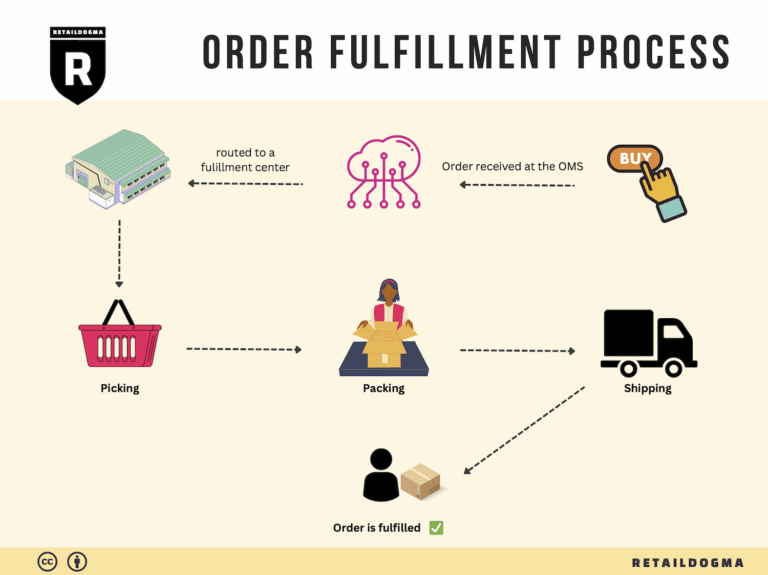How Order Fulfillment Works: A Step-by-Step Guide for Businesses
What is E-commerce Fulfillment? An Introduction for Growing Businesses
Navigating the Challenges of Order Management
As your e-commerce business grows, so does the complexity of managing orders, packing, and shipping products to customers. Many entrepreneurs find themselves overwhelmed by the sheer volume of orders, leading to potential delays, errors, and dissatisfied customers. This is a common pain point that can stifle growth and tarnish your brand’s reputation. Understanding how to effectively manage fulfillment can be a game changer for your business.
Fulfillment, in simple terms, is the process of getting a product from your inventory to your customer’s doorstep. It encompasses various stages, including receiving orders, picking items from the warehouse, packing them securely, and shipping them out in a timely manner. For growing businesses, mastering this process is crucial to maintaining customer satisfaction and driving repeat sales.
In this guide, we will delve into the essential aspects of e-commerce fulfillment that every business owner should know. We’ll explore different fulfillment models such as Third-Party Logistics (3PL) and Fulfillment by Amazon (FBA). Understanding these models will help you determine which one aligns best with your operational needs and customer expectations.
We’ll also outline the core services involved in fulfillment, including inventory management, order processing, and shipping logistics. Each of these services plays a vital role in ensuring that your customers receive their orders accurately and on time.
Choosing the right fulfillment partner is another critical decision that can significantly impact your business operations. We will provide insights on what to look for in a partner, including their technology, service offerings, and pricing structures.
Speaking of pricing, we will break down the factors that influence fulfillment costs and offer practical tips on how to optimize your budget without compromising service quality.
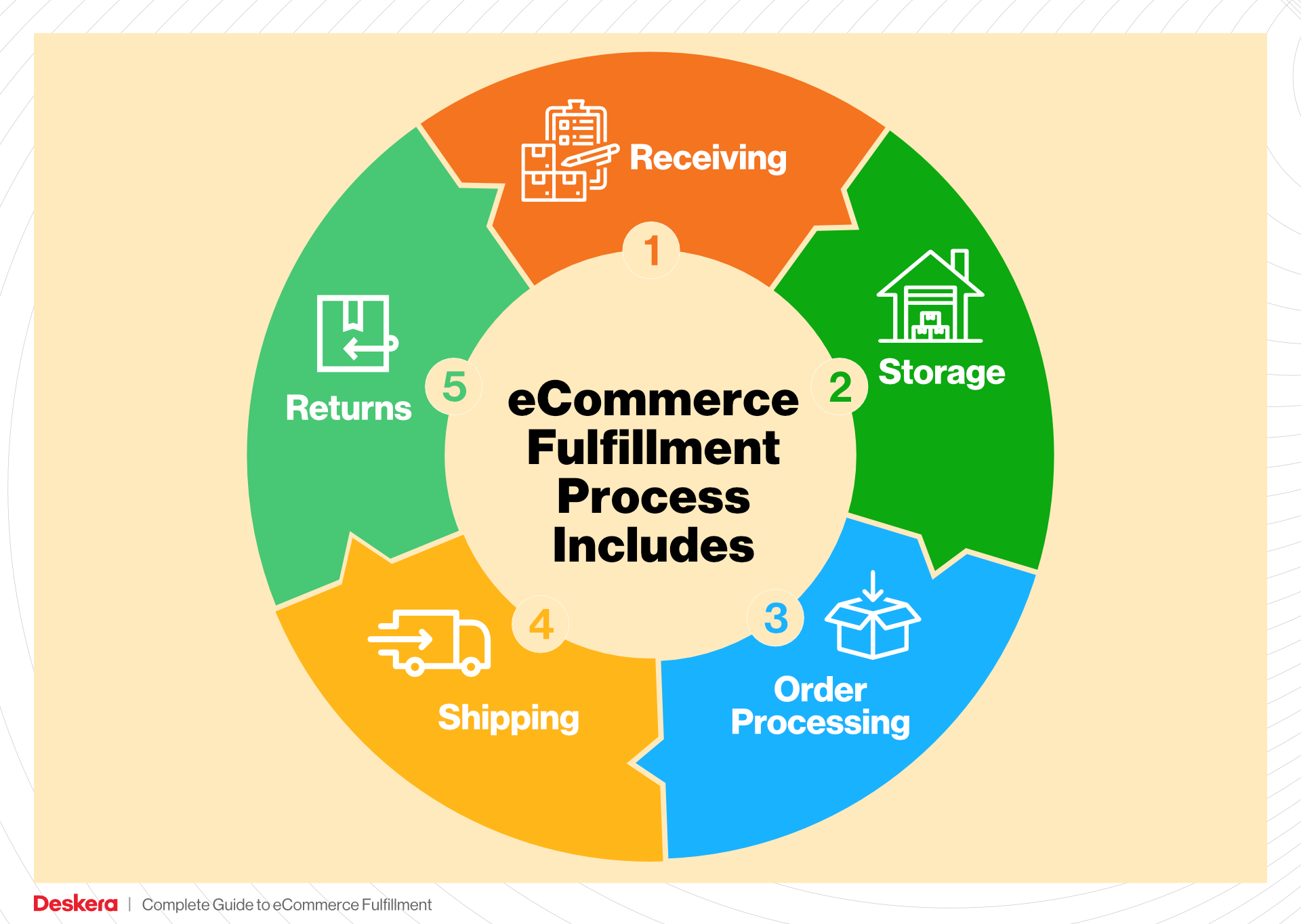
Ultimately, this guide aims to empower you, the business owner, to make informed and strategic decisions about your logistics. By understanding the intricacies of e-commerce fulfillment, you can streamline operations, enhance customer satisfaction, and position your business for sustainable growth. Let’s embark on this journey to fulfillment excellence together!
What You’ll Learn In This Guide
- What is E-commerce Fulfillment? An Introduction for Growing Businesses
- The Order Fulfillment Process: From ‘Buy’ Button to Customer’s Door
- Comparing Fulfillment Models: In-House vs. 3PL vs. Dropshipping
- A Deep Dive into Amazon FBA: Pros, Cons, and Who It’s For
- Core Services Offered by Fulfillment Centers
- How to Choose a Fulfillment Partner: A 6-Point Checklist
- Understanding Fulfillment Pricing: A Breakdown of Common Fees
- Frequently Asked Questions (FAQs) about Fulfillment
- Conclusion: Is Outsourcing Fulfillment the Right Move for Your Business?
- Important Disclaimer
The Order Fulfillment Process: From ‘Buy’ Button to Customer’s Door
1. Receiving Inventory
The first step in the order fulfillment process is receiving inventory. This involves accepting shipments from suppliers or manufacturers and verifying that the received goods match the purchase orders. During this phase, businesses typically conduct a thorough inspection to ensure that the quantity and quality of items are correct. A key term associated with this step is SKU (Stock Keeping Unit), which is a unique identifier for each product that helps in tracking inventory levels.
Receiving inventory is crucial for maintaining accurate stock levels and ensuring that your warehouse is prepared to fulfill customer orders promptly. An efficient receiving process minimizes errors, reduces the risk of stockouts, and helps establish a reliable inventory management system. Once the inventory is received and verified, it is recorded in your inventory management system, making it ready for the next steps in the fulfillment process.
2. Warehouse Storage
After receiving inventory, the next step is warehouse storage. This involves placing the products in designated storage locations within the warehouse. Effective warehouse layout and organization are vital here, as they directly impact the efficiency of order fulfillment. A commonly used term in this step is bin location, which refers to the specific spot where a product is stored.
Proper storage practices are essential for easy access to items when orders come in. By organizing products logically—based on factors such as size, weight, or sales frequency—businesses can improve picking efficiency and reduce the time it takes to locate items. Additionally, a well-maintained storage system enhances inventory accuracy, thereby preventing issues like overstocking or stockouts that can affect customer satisfaction.
3. Order Picking
Once an order is placed, the next step is order picking. This process involves selecting the correct items from the warehouse to fulfill the customer’s order. A critical tool in this phase is the pick list, which outlines the items and quantities needed for each order. The pick list is generated by the inventory management system and guides warehouse staff in retrieving the products.
Order picking is a pivotal stage in the fulfillment process because it directly affects the speed and accuracy of order delivery. Efficient picking methods, such as batch picking or zone picking, can significantly enhance productivity. Additionally, reducing picking errors is crucial, as mistakes can lead to returns and diminished customer trust. The goal is to ensure that the right items are picked in a timely manner to meet customer expectations.
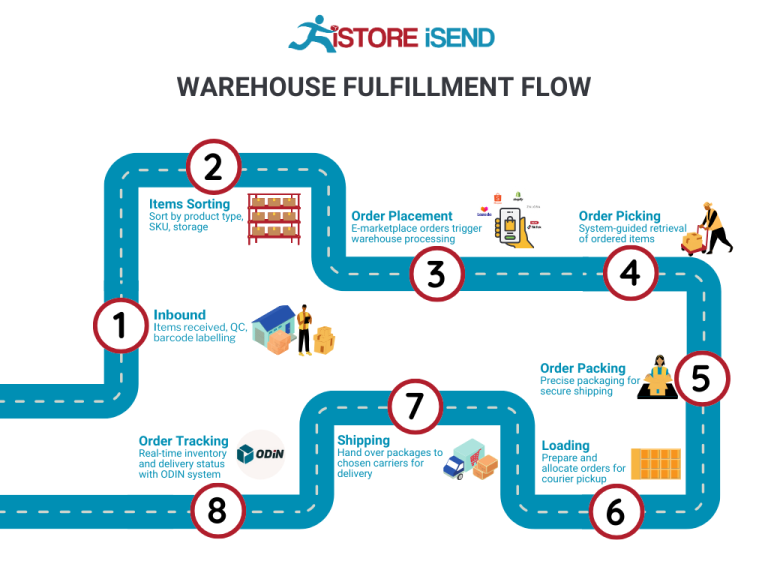
4. Order Packing
After the items have been picked, they move to the order packing stage. Here, the selected products are securely packaged for shipment. This step is essential for protecting items during transit and ensuring they arrive in excellent condition. A key term related to this process is packing slips, which are documents included in the package that detail the contents of the order.
Packing not only safeguards products but also plays a role in branding and customer experience. Using quality packing materials and including branded elements—such as thank-you notes or promotional inserts—can enhance customer satisfaction and loyalty. Furthermore, efficient packing processes help in optimizing shipping costs by reducing dimensional weight and ensuring that packages are prepared for various carriers.
5. Shipping & Delivery
The final step in the order fulfillment process is shipping and delivery. This involves selecting a carrier, generating shipping labels, and dispatching the packages to customers. The term last mile delivery is often used here, referring to the final step in the shipping process where the package is delivered to the customer’s doorstep.
Shipping and delivery are critical components of the customer experience. Timely and accurate delivery can significantly enhance customer satisfaction, while delays or errors can lead to dissatisfaction and returns. It’s essential to choose reliable shipping partners and offer customers tracking information to keep them informed about their order status. Additionally, providing various shipping options, including express or standard delivery, can cater to different customer needs and preferences, ultimately helping to boost sales and customer loyalty.
By understanding and optimizing each of these steps in the order fulfillment process, e-commerce businesses can improve operational efficiency, enhance customer satisfaction, and ultimately scale their logistics effectively.
Comparing Fulfillment Models: In-House vs. 3PL vs. Dropshipping
Fulfillment Models Overview
When scaling an e-commerce business, choosing the right fulfillment model is crucial to ensuring operational efficiency, customer satisfaction, and cost-effectiveness. Below is a comparison of three primary fulfillment models: In-House Fulfillment, Third-Party Logistics (3PL), and Dropshipping.
| Model | Who Handles Inventory | Best For (Business Stage) | Key Advantage | Key Disadvantage |
|---|---|---|---|---|
| In-House Fulfillment | The business itself | Established businesses with stable order volume | Complete control over inventory and processes | Higher overhead costs and resource requirements |
| Third-Party Logistics (3PL) | A third-party provider | Growing businesses seeking scalability | Access to specialized logistics expertise and technology | Less control over inventory and potential communication delays |
| Dropshipping | Suppliers or manufacturers | Startups or businesses testing new products | Low upfront investment and risk | Lower profit margins and reliance on suppliers for fulfillment |
In-House Fulfillment
In-house fulfillment involves managing the entire logistics process within your own organization. This model is best suited for established businesses that have a consistent and predictable order volume. Companies utilizing in-house fulfillment maintain complete control over their inventory, allowing for tailored processes, quality control, and direct oversight of operations. This can enhance customer experience by enabling faster shipping times and personalized packaging. However, the key disadvantage of this model is the higher overhead costs associated with warehousing, staffing, and technology investments. As businesses grow, scaling operations can become cumbersome and resource-intensive, leading to potential inefficiencies if not managed properly.
Third-Party Logistics (3PL)
Third-party logistics (3PL) providers offer outsourced logistics services that include inventory management, warehousing, order fulfillment, and shipping. This model is ideal for growing businesses that seek to scale their operations without the complexities of managing logistics in-house. By partnering with a 3PL, businesses can leverage the provider’s specialized expertise, technology, and infrastructure, which can lead to improved efficiency and reduced shipping costs. Additionally, 3PLs often have established relationships with carriers, enabling better shipping rates and faster delivery times. However, the downside is that businesses relinquish some control over their inventory and fulfillment processes. This can lead to potential communication delays or issues if the 3PL does not meet service expectations, impacting customer satisfaction.
Dropshipping
Dropshipping is a fulfillment model where the retailer does not hold inventory but instead relies on suppliers or manufacturers to ship products directly to customers. This model is particularly attractive for startups or businesses looking to test new product lines with minimal risk and investment. Since there is no need for warehousing or upfront inventory purchases, the financial barrier to entry is significantly lower. Retailers can offer a wide range of products without the burden of managing stock, allowing for greater flexibility in product offerings. However, dropshipping comes with its own set of challenges. Profit margins can be lower compared to other fulfillment methods, as retailers often pay a premium for the convenience of not holding inventory. Additionally, the reliance on suppliers for fulfillment can lead to issues such as stockouts, shipping delays, or quality control problems, which can adversely affect the customer experience.
Conclusion
Choosing the right fulfillment model is critical for e-commerce businesses, as each option presents unique advantages and challenges. In-house fulfillment offers complete control but comes with higher operational costs. Third-party logistics provide scalability and expertise, albeit at the cost of some control. Meanwhile, dropshipping minimizes risk and investment but can lead to lower margins and dependency on suppliers. As your business evolves, it is essential to assess your specific needs, order volume, and growth trajectory to select the most appropriate fulfillment strategy that aligns with your operational goals and customer expectations.
A Deep Dive into Amazon FBA: Pros, Cons, and Who It’s For
Understanding Fulfillment by Amazon (FBA)
Fulfillment by Amazon (FBA) is a service provided by Amazon that allows sellers to store their products in Amazon’s fulfillment centers. Amazon then takes care of storage, packaging, and shipping of these products directly to customers. This service enables sellers to leverage Amazon’s vast logistics network and customer base, allowing them to focus on other aspects of their business, such as product development and marketing.
How FBA Works
When a seller enrolls in FBA, they send their products to Amazon’s warehouses. Once the products are received, they are stored until an order is placed. When a customer orders a product, Amazon picks, packs, and ships the item on behalf of the seller. Additionally, FBA products are eligible for Amazon Prime and other Amazon services, which can enhance visibility and sales.
The process generally involves the following steps:
- Create an Amazon Seller Account: Sellers need to set up an account on Amazon Seller Central and choose FBA as their fulfillment method.
- List Products: Sellers list their products on Amazon, indicating that they are using FBA.
- Prepare Inventory: Sellers must prepare their products according to Amazon’s guidelines to ensure they are packaged and labeled correctly.
- Ship Inventory to Amazon: Sellers send their products to Amazon’s fulfillment centers, where they are stored until sold.
- Order Fulfillment: Once an order is placed, Amazon handles the picking, packing, and shipping of the product to the customer.
- Customer Service and Returns: Amazon also manages customer service and returns for FBA orders, streamlining the process for sellers.
Pros of Using Amazon FBA
1. Prime Eligibility
One of the most significant advantages of FBA is that products fulfilled by Amazon are eligible for Amazon Prime. This not only boosts the visibility of products but also attracts a large pool of Prime members who prioritize fast and free shipping. This can lead to increased sales and customer loyalty.
2. Increased Customer Trust
By using FBA, sellers benefit from Amazon’s trusted brand. Customers tend to have more confidence in purchasing products that are fulfilled by Amazon due to the company’s established reputation for reliability and customer service. This can lead to higher conversion rates and fewer returns.
3. Multi-Channel Fulfillment
FBA is not limited to just Amazon.com; sellers can also use FBA to fulfill orders from other sales channels, such as their own websites or other marketplaces. This multi-channel fulfillment capability allows businesses to streamline their logistics while still tapping into Amazon’s efficient shipping processes.

4. Simplified Logistics
With FBA, sellers can offload the complexities of storage, packing, and shipping to Amazon. This allows them to focus on product sourcing, marketing, and customer engagement rather than the logistical challenges of order fulfillment.
5. Access to Advanced Analytics
Amazon provides sellers with detailed analytics and reporting through Seller Central. This data can help sellers make informed decisions regarding inventory management, sales forecasting, and marketing strategies.
Cons of Using Amazon FBA
1. High Fees
While FBA provides numerous benefits, it also comes with costs that can add up quickly. Sellers are charged for storage, fulfillment, and other associated services. These fees can significantly reduce profit margins, especially for low-cost items or those with thin margins.
2. Strict Inventory Rules
Amazon has stringent inventory management policies that sellers must adhere to. This includes limits on the number of units that can be stored in their fulfillment centers, especially during peak seasons. Sellers who do not comply with these rules may face penalties or even suspension of their accounts.
3. Commingling Risks
FBA involves a practice known as commingling, where products from different sellers are stored together. While this can simplify inventory management, it also poses risks. If a customer receives a damaged or defective item that originated from another seller, it can negatively impact the original seller’s reputation and lead to returns or negative feedback.
4. Loss of Control
Using FBA means relinquishing some control over the fulfillment process. Sellers are dependent on Amazon’s operations, which can lead to challenges if there are issues with inventory management, shipping delays, or customer service responses.
5. Complexity in Returns
While Amazon handles returns for FBA sellers, the process can sometimes be complex. Mismanaged returns or damaged products can lead to disputes, and sellers might find it challenging to track return statuses or manage customer expectations.
Who is FBA Best For?
Fulfillment by Amazon is particularly well-suited for certain types of businesses:
- Small to Medium-Sized Businesses: Businesses that lack the resources to manage their own warehousing and logistics can benefit significantly from FBA.
- E-commerce Startups: New sellers looking to quickly establish their online presence can leverage Amazon’s extensive reach and logistics without heavy upfront investments in infrastructure.
- Sellers with High Turnover Products: Those selling fast-moving consumer goods or trending items can take advantage of FBA to ensure their products are always in stock and ready to ship.
- Businesses Targeting Amazon Prime Customers: Brands that want to reach the vast Prime member base will find FBA advantageous due to the eligibility for Prime shipping.
- Multi-Channel Sellers: Businesses that sell across different platforms and want to streamline their logistics while maintaining a presence on Amazon can benefit from FBA’s multi-channel fulfillment capabilities.
In conclusion, Fulfillment by Amazon offers a robust solution for e-commerce businesses looking to scale efficiently. While it comes with its own set of challenges, the benefits often outweigh the drawbacks for many sellers, especially those who prioritize customer trust and convenience. Understanding the nuances of FBA can help businesses make informed decisions about whether to integrate this model into their operations.
Core Services Offered by Fulfillment Centers
Inventory Management & Warehousing
Fulfillment centers offer sophisticated inventory management and warehousing solutions designed to streamline e-commerce operations. This service encompasses the storage, tracking, and management of products before they are shipped to customers. Fulfillment centers utilize advanced technology, such as inventory management software, to provide real-time visibility into stock levels, allowing businesses to make informed decisions about restocking and order fulfillment.
Benefits:
-
Optimized Space Utilization: By outsourcing warehousing to fulfillment centers, businesses can avoid the costs and complexities associated with maintaining their own storage facilities. Fulfillment centers typically have the infrastructure to handle large volumes of inventory efficiently.
-
Reduced Overhead Costs: Businesses can save on operational costs related to rent, utilities, and labor associated with managing their own warehouses. This allows them to allocate resources more effectively toward growth and marketing.
-
Scalability: As e-commerce businesses grow, their inventory needs can fluctuate dramatically. Fulfillment centers provide flexible warehousing solutions that can scale with demand, ensuring that businesses are always prepared to meet customer expectations without unnecessary delays.
-
Improved Accuracy: Automated inventory systems reduce the risk of human error in stock management, leading to fewer stockouts and overstock situations. This accuracy ensures that businesses can maintain customer satisfaction by delivering orders on time and in full.
Pick and Pack Services
Pick and pack services are at the heart of any fulfillment operation. This process involves selecting items from the warehouse, packing them for shipment, and preparing them for delivery to customers. Fulfillment centers utilize streamlined workflows and technology to ensure that orders are processed quickly and accurately.
Benefits:
-
Speed and Efficiency: Fulfillment centers are designed to handle high volumes of orders rapidly. With dedicated staff and optimized processes, they can significantly reduce order processing times, leading to faster shipping and happier customers.
-
Accuracy in Order Fulfillment: Advanced picking technologies, such as barcode scanning, minimize the risk of errors during the picking process. This accuracy translates to fewer returns and exchanges, enhancing customer satisfaction and reducing operational costs related to handling returns.
-
Customizable Packing Options: Fulfillment centers can accommodate various packing requirements, whether it’s standard boxes, branded packaging, or special handling for fragile items. This flexibility allows e-commerce businesses to present their products in a way that aligns with their brand identity.
-
Integration with E-commerce Platforms: Most fulfillment centers offer integrations with popular e-commerce platforms, allowing for seamless order processing. This integration streamlines operations and reduces the workload on internal teams, enabling them to focus on growth strategies.
Kitting and Assembly
Kitting and assembly services involve grouping individual items into a single package or creating finished products from multiple components. This service is particularly valuable for businesses that sell products that require assembly or those that offer bundled products.
Benefits:
-
Enhanced Product Offerings: Kitting allows businesses to create unique product offerings by bundling complementary items together. This not only increases the perceived value for customers but can also lead to higher average order values.
-
Streamlined Operations: By outsourcing kitting and assembly to fulfillment centers, businesses can save time and resources that would otherwise be spent on these labor-intensive processes. This efficiency allows internal teams to focus on core business functions.
-
Consistency in Quality: Fulfillment centers typically have established processes for kitting and assembly, ensuring that products are assembled correctly and consistently. This consistency helps maintain brand reputation and customer trust.
-
Reduced Time to Market: For businesses launching new products, having a fulfillment center handle kitting can significantly speed up the time to market. They can quickly assemble and package products, ensuring that businesses can capitalize on new opportunities without delays.
Returns Management (Reverse Logistics)
Returns management, or reverse logistics, is a crucial service offered by fulfillment centers that focuses on handling returned products efficiently. This process includes receiving returned items, inspecting their condition, restocking them, and managing the entire return process seamlessly.
Benefits:
-
Improved Customer Experience: A smooth returns process can greatly enhance customer satisfaction. Fulfillment centers provide easy-to-follow return procedures, ensuring that customers feel valued and supported, which can lead to repeat business.
-
Cost Management: Efficient returns management helps businesses minimize losses associated with returned items. Fulfillment centers can determine whether items can be restocked, repaired, or need to be discarded, allowing businesses to recover as much value as possible.
-
Data Insights: Fulfillment centers often provide analytics on return reasons and patterns, which can help businesses identify issues with products or customer expectations. This data can inform product improvements and marketing strategies, ultimately reducing future returns.
-
Focus on Core Competencies: By outsourcing returns management, businesses can free up internal resources and focus on growth initiatives, product development, and marketing, rather than getting bogged down in the complexities of handling returns.
In conclusion, partnering with a fulfillment center can provide e-commerce businesses with a comprehensive suite of services that enhance operational efficiency, improve customer satisfaction, and ultimately drive growth. By leveraging these core services—inventory management and warehousing, pick and pack, kitting and assembly, and returns management—businesses can scale effectively and focus on what they do best.
How to Choose a Fulfillment Partner: A 6-Point Checklist
Location & Warehouse Network
Importance: The geographic location of your fulfillment partner’s warehouses significantly impacts shipping times and costs. A strategically placed warehouse network can enhance delivery speed, reduce shipping expenses, and improve overall customer satisfaction.
Questions to Ask:
– Where are your warehouses located, and how does this align with our target customer base?
– What shipping carriers do you partner with, and what are their delivery times to our primary regions?
– Do you offer multiple fulfillment centers to allow for regional distribution?
Technology & Integrations
Importance: A modern fulfillment partner should have robust technology that integrates seamlessly with your e-commerce platform. This integration facilitates real-time inventory management, order tracking, and data synchronization, which are crucial for operational efficiency.
Questions to Ask:
– What technology platform do you use for order management, and how does it integrate with our existing systems (e.g., Shopify, WooCommerce, Amazon)?
– Can your system provide real-time inventory updates and order tracking for our customers?
– Do you offer APIs or other tools for custom integrations?
Specializations (e.g., cold storage, oversized items)
Importance: Depending on your product line, your fulfillment partner may need to specialize in certain areas, such as cold storage for perishable goods or handling oversized items. Choosing a partner with the right expertise can prevent logistical headaches and ensure compliance with industry regulations.
Questions to Ask:
– Do you have experience handling our specific types of products, such as perishables, hazardous materials, or oversized items?
– What facilities and equipment do you have in place to accommodate special storage needs?
– How do you ensure compliance with safety regulations for specialized products?
Scalability & Capacity
Importance: As your business grows, your fulfillment needs will evolve. It’s critical to partner with a provider that can scale operations to meet increasing demand without compromising service quality.
Questions to Ask:
– How do you handle seasonal spikes in order volume?
– What is your capacity for scaling operations, and how quickly can you adjust to our growth?
– Can you provide examples of how you have successfully scaled for other clients?
Pricing and Contracts
Importance: Understanding the pricing structure and contract terms is essential to avoid unexpected costs and ensure a mutually beneficial partnership. Transparent pricing helps in budgeting and financial planning.
Questions to Ask:
– What is your pricing model (e.g., per order, per item, monthly fees), and are there any hidden fees?
– Can you provide a detailed breakdown of costs associated with storage, picking, packing, and shipping?
– What are the terms of your contract, including cancellation policies and any penalties for early termination?
Customer Support & Reviews
Importance: Reliable customer support is crucial for resolving issues swiftly and maintaining operational continuity. Additionally, reviews and testimonials from other clients can provide insight into the partner’s reliability and service quality.
Questions to Ask:
– What customer support channels do you offer (e.g., phone, email, chat), and what are your support hours?
– Can you provide references or case studies from businesses similar to ours?
– How do you handle disputes or issues that may arise during the fulfillment process?
Conclusion
Choosing the right fulfillment partner is a pivotal decision that can significantly influence your e-commerce operations. By using this checklist, you can assess potential partners based on critical factors that align with your business goals. Conduct thorough research, ask the right questions, and ensure that your chosen partner will not only meet your current needs but also support your growth in the future.
Understanding Fulfillment Pricing: A Breakdown of Common Fees
Initial Setup Fees
Initial setup fees are often charged by fulfillment centers to establish your account and prepare your inventory for storage and order processing. These fees typically cover the cost of onboarding, which may include account configuration, software integration, and initial training sessions.
The calculation of initial setup fees can vary significantly between providers. Some may charge a flat fee, while others may base it on the complexity of your operations, including the number of SKUs (Stock Keeping Units) you plan to manage. It’s essential to ask for a detailed breakdown of what the setup fee entails, as some fulfillment centers may include additional services such as branding options or custom packaging in this fee.
Receiving Fees
Receiving fees are charged when your inventory arrives at the fulfillment center. This fee covers the labor involved in unloading, inspecting, and storing your products. Fulfillment centers typically charge this fee based on the number of pallets or individual items received.
For example, a fulfillment provider may charge a per-pallet fee, which could range from $20 to $50, or a per-item fee that might be around $0.25 to $1.00. Factors that can influence receiving fees include the complexity of the product (e.g., fragile items may require more careful handling) and the overall volume of inventory being processed.
Storage Fees (per pallet/bin)
Storage fees are incurred for keeping your inventory at the fulfillment center. These fees are usually charged on a monthly basis and can be calculated per pallet or per bin, depending on how your items are stored.
The average monthly storage fee for a pallet can range from $10 to $40, while bin storage fees might be lower, around $5 to $15 per bin. It’s important to note that some fulfillment centers have minimum storage requirements, which can affect your overall costs. Additionally, you may encounter overage fees if your inventory exceeds the agreed-upon storage limits.
Pick & Pack Fees (per item/order)
Pick and pack fees are charged for the labor involved in selecting items from inventory and preparing them for shipment. This fee is often calculated on a per-item or per-order basis.
For instance, a fulfillment center may charge around $1.00 to $3.00 per order, plus an additional fee of $0.25 to $0.75 for each item picked. Variations in these fees can occur based on the complexity of the order (e.g., multiple items in one order may increase the fee) and any special packing requirements (e.g., gift wrapping or special labeling).
Shipping Fees
Shipping fees are one of the most variable costs in fulfillment pricing and can depend on several factors, including the destination, shipping method (ground, expedited, international), and the size and weight of the packages.
Fulfillment centers often have partnerships with major carriers (like UPS, FedEx, or DHL) and may offer discounted shipping rates. However, it’s crucial to understand whether the shipping fee is included in your overall fulfillment agreement or if it’s billed separately. Some providers may charge a handling fee on top of the shipping cost, which can range from $0.50 to $2.00 per package.
Tips for Getting an Accurate Quote
To obtain an accurate quote for fulfillment services, consider the following tips:
-
Define Your Needs: Clearly outline your product types, expected order volumes, and specific requirements (like packaging or branding) to ensure you receive a tailored quote.
-
Request Detailed Breakdowns: Ask fulfillment centers for a detailed explanation of their fee structures, including any potential hidden costs that may arise.
-
Compare Multiple Providers: Don’t settle for the first quote you receive. Compare pricing and services from multiple fulfillment centers to identify the best fit for your business.
-
Inquire About Discounts: Some providers may offer discounts for higher volumes or longer-term contracts. Be sure to ask about any available pricing incentives.
-
Consider Location: The geographical location of the fulfillment center can impact shipping costs. Evaluate whether the center is strategically located to minimize shipping times and costs to your customers.
By understanding these common fulfillment pricing models and following these tips, you can better navigate the complexities of fulfillment fees and choose a provider that aligns with your operational needs and budget.
Frequently Asked Questions (FAQs) about Fulfillment
1. How do you spell fulfillment?
The term can be spelled as “fulfillment” (American English) or “fulfilment” (British English). The choice of spelling should be based on your target audience’s regional preferences.
2. What’s the difference between a warehouse and a fulfillment center?
A warehouse is primarily used for storing goods, while a fulfillment center is designed for order processing, including picking, packing, and shipping products directly to customers. Fulfillment centers often have technology and systems in place to streamline these processes and improve efficiency.
3. What is a 3PL?
A 3PL, or third-party logistics provider, is a company that offers logistics services to businesses, including warehousing, fulfillment, inventory management, and shipping. By outsourcing these functions to a 3PL, businesses can focus on core activities while leveraging the provider’s expertise and resources.
4. How much do fulfillment services cost?
Fulfillment service costs can vary widely based on factors such as order volume, storage space needed, packaging requirements, and shipping methods. On average, businesses can expect to pay a combination of monthly storage fees, per-order fulfillment fees, and shipping costs. It’s essential to request quotes from multiple providers to find the best fit for your budget and needs.
5. Why is spelling important in e-commerce fulfillment?
Using the correct spelling of “fulfillment” or “fulfilment” is vital for maintaining professionalism and credibility with your audience. Additionally, it impacts your SEO strategy, as search engines may deliver different results based on the spelling used, affecting your website’s visibility in various markets.
6. Can I use both spellings on my website?
While it’s possible to use both spellings, it’s best practice to choose one based on your primary audience and use it consistently throughout your website. This helps avoid confusion and maintains a professional appearance.
7. How can I optimize my website for SEO regarding fulfillment?
To optimize your website for SEO, use “fulfillment” in content and metadata if targeting the U.S. market, and “fulfilment” for UK or Commonwealth audiences. Consider creating separate localized versions of your site to align with regional spelling conventions, which can enhance your visibility in search results.
8. What are common fulfillment strategies for e-commerce businesses?
Common fulfillment strategies include in-house fulfillment, outsourcing to a 3PL, dropshipping, and hybrid models. Each approach has its advantages and disadvantages, so businesses should evaluate their specific needs, order volume, and customer expectations to choose the best strategy.
9. How does fulfillment impact customer satisfaction?
Effective fulfillment is crucial for customer satisfaction. Timely order processing, accurate inventory management, and reliable shipping can enhance the overall shopping experience. Delays or errors in fulfillment can lead to customer dissatisfaction and harm your brand’s reputation.
10. What role does technology play in fulfillment?
Technology plays a significant role in modern fulfillment operations. Inventory management systems, order processing software, and automated picking and packing solutions help streamline operations, reduce errors, and improve efficiency. Leveraging technology can lead to faster delivery times and a better customer experience.
Conclusion: Is Outsourcing Fulfillment the Right Move for Your Business?
Evaluating the Benefits of Outsourcing Fulfillment
Outsourcing fulfillment can be a game-changer for e-commerce businesses looking to scale. One of the most compelling advantages is time savings. By partnering with a fulfillment service, you can redirect your focus from logistics and order management to strategic activities that drive growth, such as marketing and customer engagement. This shift not only enhances productivity but also allows you to innovate and adapt to market demands more swiftly.
Additionally, scalability is a critical benefit of using a fulfillment partner. As your business grows, so do your logistical needs. A proficient fulfillment service can seamlessly handle increased order volumes, seasonal spikes, and even international shipping without requiring you to invest heavily in infrastructure or additional staff. This flexibility is essential for maintaining service quality and customer satisfaction as your operations expand.
Furthermore, leveraging the expertise of a fulfillment provider can significantly enhance your operational efficiency. These partners come equipped with advanced technologies, established networks, and industry know-how that can streamline your supply chain and improve delivery times. Their experience can also help you navigate complex challenges, from inventory management to compliance with international shipping regulations.
However, the choice of fulfillment partner is paramount. Not all providers offer the same level of service, and selecting the right one can impact your brand’s reputation and customer experience. Conduct thorough research to find a partner that aligns with your business goals and values.
Take Action Today
To determine if outsourcing fulfillment is the right next step for your business, start by auditing your current shipping processes. Identify bottlenecks, assess costs, and evaluate how much time you or your team spend on fulfillment-related tasks. This analysis will provide clarity on whether a fulfillment partner could enhance your operations and support your growth strategy. Taking this proactive step can lead you towards a more efficient and scalable future in e-commerce.
Important Disclaimer
⚠️ Important Disclaimer
The information in this guide is for educational purposes. Fulfillment services, pricing, and platform features change frequently. Always conduct your own due diligence and consult with providers directly before making business decisions.
